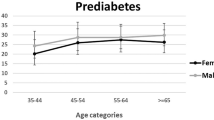Abstract
Diabetes mellitus, a chronic metabolic disease that can lead to severe complications and even death in affected individuals, is on the rise worldwide. In 2011, an estimated 185 million people were living with diabetes, with a projected prevalence of 276 million by 2030. In Afghanistan, reliable published information about diabetes mellitus is unavailable. Therefore, a cross-sectional study was conducted during December 2011–March 2012 to estimate the prevalence and determine factors for diabetes mellitus among adults living in urban Kabul. A multistage random sampling technique was used to recruit adults of ≥40 years. Background data, blood pressure, body mass index, and blood sugar were obtained via a structured questionnaire, physical examinations, and blood specimen. Individuals previously diagnosed with diabetes mellitus or those having a fasting blood sugar >126 mg% were considered as diabetes mellitus. Univariate and multivariate analyses were performed using SPSS version 20. Out of total 1183 participants, 157 (13.2 %, confidence interval (CI 12.2–14.2) were identified as diabetes mellitus. Factors independently associated with diabetes mellitus were age with cutoff 45 years (OR=1.59, CI 1.04 - 2.44), educaiton level (OR=1.90, CI 1.21 - 3.01) family history of diabetes (odds ratios (OR) = 8.5, CI 5–14), sedentary lifestyle (OR = 3.6, CI 1.8–7.3), eating rice (OR = 2.0, CI 1.3–3.1), using a car for transportation (OR = 2.3, CI 1.2–4.8), hypertension (OR = 1.8, CI 1.2–2.8), and using liquid cooking oil (OR = 0.4, CI 0.3–0.6). Measures such as raising awareness and lifestyle modifications may help to reduce the burden of the disease among adults in Kabul.
Similar content being viewed by others
References
Lozano R, Naghavi M, Foreman K, Lim S, Shibuya K, Aboyans V, et al. Global and regional mortality from 235 causes of death for 20 age groups in 1990 and 2010: a systematic analysis for the global burden of disease study 2010. Lancet. 2012;380:2095–128.
World Health Organization. Diabetes. WHO Media Center, Fact Sheet # 312 November 2009
American Diabetes Association (ADA): Clinical practice recommendation 2003. Diabetes Care 2003, 26 (Suppl 1).
Whiting DR, Guariguata L, Weil C, Shaw J. IDF diabetes atlas: global estimates of the prevalence of diabetes for 2011 and 2030. Diabetes Res Clin Pract. 2011;94:311–21.
Wild S, Roglic G, Green A, Sicree R, King H. Global prevalence of diabetes. Estimates for the year 2000 and projections for 2030. Diabetic Care. 2004;27(5):1047–53.
Gaffar A, Reddy KS, Singhi M. Burden of non-communicable disease in south Asia. BMJ. 2004;328(7443):897–10.
Basti A, Fawwad A, Hakeem R, Ahmedani MY, Zafar MM. Pakistan national diabetes survey: prevalence of glucose intolerance and associated factors in the Punjab province of Pakistan. J Prim Care Diabetes Eur. 2010;4(2):79–83.
Esteghamati A, Meysamie A, Khalilzadeh O, Rashidi A, Haghazali M, Asgari F, et al. Third national surveillance of risk factors of non-communicable diseases (SuRFNCD-2007) in Iran: methods and results on prevalence of diabetes, hypertension, obesity, central obesity, and dyslipidemia. BMC Public Health. 2009;9:167.
Gu D, Reynolds K, Duan X, Xin X, Chen J, Wu X, et al. Prevalence of diabetes and impaired fasting glucose in the Chinese adult population: international collaborative study of cardiovascular disease in Asia (InterASIA). Diabetologia. 2003;46(9):1190–8.
World Health Organization. Diabetes Programme. Country and regional data on diabetes. Prevalence of diabetes in the WHO Eastern Mediterranean Region. (access August 2010) website: http://www.who.int/diabetes/facts/world_figures/en/index2.html
Ramachandran A. Urban India: a breeding ground for diabetes. Diabetes Voice. 2002;47(1):18–20.
Al-Mosa S. Allin S. Jemiai N. Al-Lawati J. Mossialos M. Diabetes and urbanization in the Omani population: an analysis of national survey data. Population Health Metrics. Available at: http://www.pophealthmetrics.com
Kokiwar PR, Gupta S, Durge PM. Prevalence of diabetes in a rural area of central India. Int J Diab Dev Ctries. 2002;27:8–10.
Esteghamati A, Gouya MM, Abbasi M, Delavari A, Alikhani S, Alaedini F, et al. Prevalence of diabetes and impaired fasting glucose in the adult population of Iran: national survey of risk factors for non-communicable diseases of Iran. Diabetes Care. 2008;31(1):96–8.
World Health Organization. Obesity: preventing and managing the global epidemic. Geneva: World Health Organization; 2000 (WHO Technical Report Series No.894)
International Diabetes Federation: The IDF consensus worldwide definitions of the metabolic syndrome. Available online : http://www.idf.org/webdata/docs/IDF_Meta_def_final.pdf, 2006
Whitworth JA. World Health Organization (WHO)/International society of Hypertension (ISH) statement on management of hypertension. J Hypertens. 2003;21:1982–92.
Zafar J, et al. Prevalence and risk factors for diabetes mellitus in a selected urban population of a city of Punjab. Journal of Pakistan Medical Association 61 (1), Jan 2011
Ning F, Pang ZC, Dong YH, Gao WG, Nan HR, Wang SJ, et al. Risk factors associated with the dramatic increase in the prevalence of diabetes in the adult Chinese population in Qingdao. China Diabetic Med. 2009;26:855–63.
Shaw JE, Sicree RA, Zimmet PZ, Diabetes Atlas. Global estimates of the prevalence of diabetes for 2010 and 2030. Diabetes Res Clin Pract. 2010;87:4–14.
Author information
Authors and Affiliations
Corresponding author
Rights and permissions
About this article
Cite this article
Saeed, K.M.I., Asghar, R.J., Sahak, M.N. et al. Prevalence and risk factors associated with diabetes mellitus among Kabul citizens—Afghanistan, 2012. Int J Diabetes Dev Ctries 35, 297–303 (2015). https://doi.org/10.1007/s13410-014-0270-3
Received:
Accepted:
Published:
Issue Date:
DOI: https://doi.org/10.1007/s13410-014-0270-3




